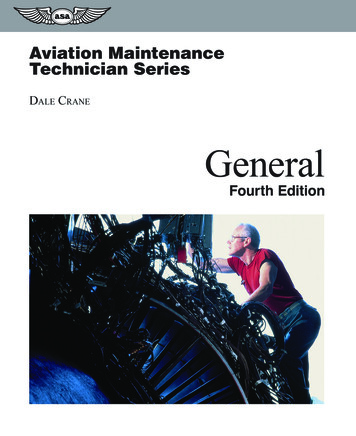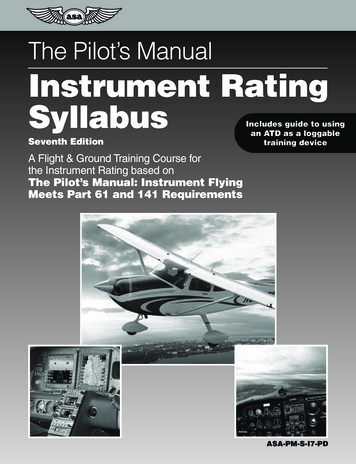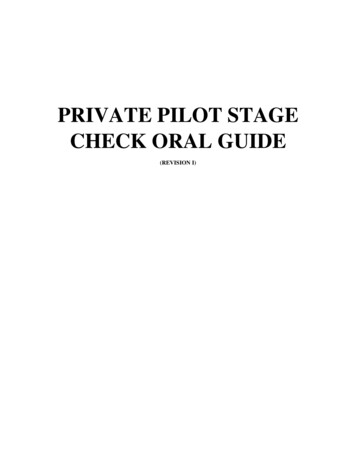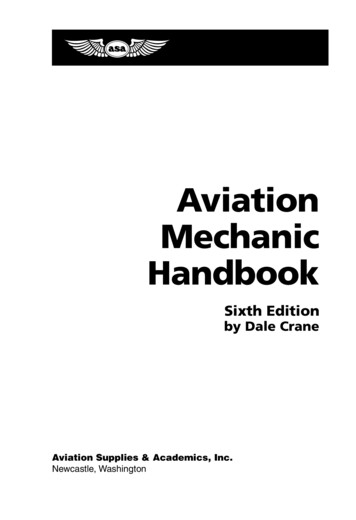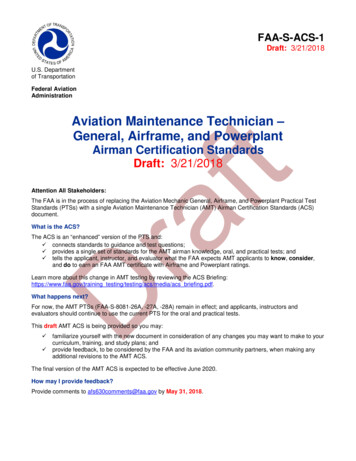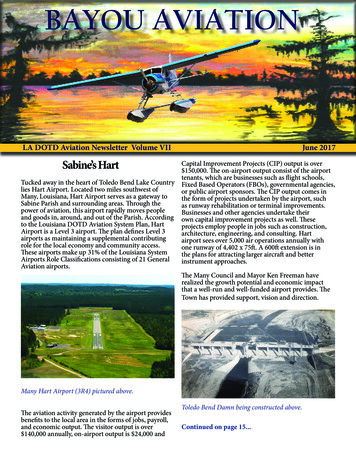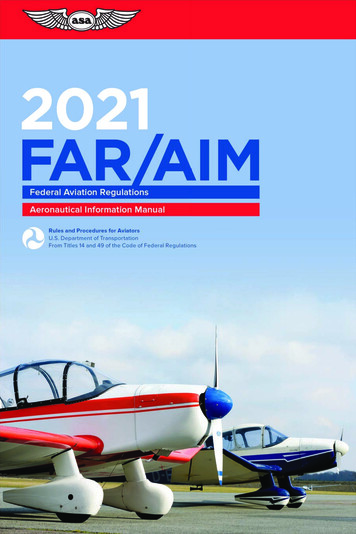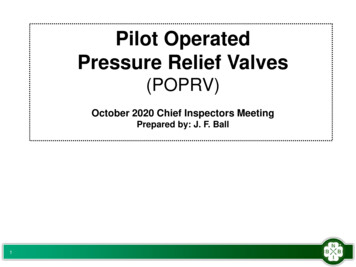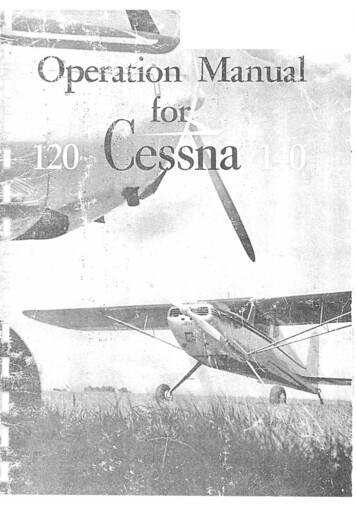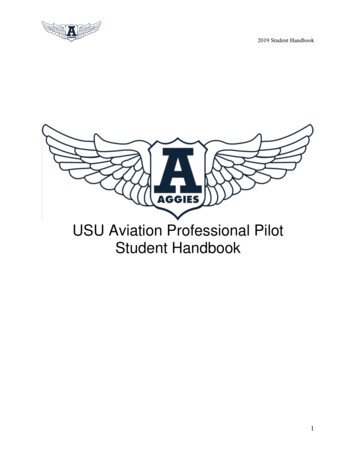
Transcription
2019 Student HandbookUSU Aviation Professional PilotStudent Handbook1
2019 Student HandbookWelcome to the USU Aviation Technology-Professional Pilot Program. We hope you willfind your experiences in this program to be exciting and motivating as you prepare for acareer in aviation.The flight training program at Utah State University must adhere not only to all universitypolicies, but also to the Federal Aviation Regulations, aircraft and airport policies.This manual will help guide users through the various levels and stages required tobecome a professional pilot and the requirements set forth by the program for safeaircraft operation and pilot professionalismAll pilots (Students, Instructors, staff, and Examiners) of USU aircraft are subject to thefollowing rules and may not violate these unless explicitly permitted by the Chief FlightInstructor.2
2019 Student HandbookContentsDirectoryNew StudentsAppendix A – Student Conduct Ethical Conduct Alcohol and Drug Use Honesty/Integrity Cheating Notification & Communication Disciplinary Action Flight Uniforms and Dress CodeAppendix B – Training Guidelines Attendance Availability Flight Course Grading Standards of Progress Failure to Progress Stage and End of Course Written Exams Stage and End of Course Checko Gradingo Oralo Practical Flying Prerequisites Pre-Requisites for Ground Courses Pre-Requisites for Flight Courses University Drop PolicyAppendix C – Documentation Student Pilot Certificate Medical Certificate TSA Documentationo Domestic Studentso International Students3
2019 Student HandbookAppendix D – Fees Uniforms and Jackets Pilot Supplies Flight Course FeesAppendix E – Talon & Scheduling Talon Scheduling Availability Flight Late Returns Scheduling FAA Checkrides Scheduling FAA Written Tests Cancellation PolicyAppendix F – Aircraft Operations Operations Manual – Airplane1) All Flights2) Weather Minimums3) Collision Avoidance4) Taxiing Precautions5) Practice Areas6) Flight Altitudes7) Inflight Operations8) Precautionary Landings9) Maintenance and Squawks10) Fuel11) Ramp Operations Procedures12) Aircraft Performance13) Emergency Procedures14) Maneuver Limitations15) Cross Country Flights16) Overall Health and Safety17) Electronic Record Keeping18) End of Day Procedures19) Maintenance Test Flights4
Operations Manual – Helicopter1) All Flights2) Weather Minimums3) Collision Avoidance4) Taxiing Precautions5) Practice Areas6) Flight Altitudes7) Inflight Operations8) Precautionary Landings9) Maintenance and Squawks10) Fuel11) Ramp Operations Procedures12) Aircraft Performance13) Emergency Procedures14) Maneuver Limitations15) Cross Country Flights16) Overall Health and Safety17) Restrictions for Practice Autorotation18) End of Day Procedures19) Maintenance Test Flights20) Over-speed Prevention21) Electronic Record Keeping2019 Student HandbookAppendix G – Approved AirportsAppendix H – Practice Areas5
2019 Student HandbookDirectoryAcademic AdvisorKaylee Roholtkaylee.roholt@usu.edu(435) 797-1795Dispatch Desk(435) 797-7897Chief Flight InstructorAaron Dychesaaron.dyches@usu.edu(435) 797-7894Assistant Chief Flight InstructorsJon Murdochjon.murdoch@usu.edu(435) 797-7335Brandon Parishbrandon.parish@usu.edu(435) 797-7892Ashley Martinezashley.martinez@usu.eduSteve Gasiksteven.gasik@usu.edu6
2019 Student HandbookAirport Student ServicesJoran IvieEmail: joran.ivie@usu.eduPhone: (435) 797-78937
2019 Student HandbookNew StudentsWelcome new Flying Aggies! We are excited to have you with us. Please read thehandbook in its entirety so that there will be no training or policy surprises. If at any timestudents find themselves left with additional questions please contact us as soon aspossible so that any issues can be resolved.Please note before you start flying you need ALL of the following:Current FAA Class Medical (see Appendix C)Student Pilot license (see Appendix C)TSA Clearance (see Appendix C)Funds secure in Talon (see Appendix D)All of these must be in place by the end of the first week, Friday, of the semester. If thestudent does not they will automatically be dropped from the flying and ground schoolcourses. Students may reenroll if they obtain the necessary documentation before thesemester add/drop date.Students must also make a few purchases when starting their careers in aviation. A fewof these items and their associated costs are below and covered in Appendix D.The following items will need to be purchased at the Logan-Cache Airport:USU Flight Uniform 40Aircraft Checklist 8Diamond DA40 POH 30Additionally, these items will be needed as well, but can be purchased at online retailerssuch as Amazon or Sporty’s Pilot Shop:Federal Aviation Regulations Book 30Flashlight with red filter 20 - 100Headset - Large price range. A good one that will last all of training expect tospend at least 200- 400Additional information on purchases can be found in Appendix D.8
2019 Student HandbookAppendix AStudent Conduct9
2019 Student HandbookEthical ConductIn its programs and activities, Utah State University does not discriminate based onrace, color, religion, sex, national origin, age, genetic information, sexual orientation orgender identity/expression, disability, status as a protected veteran, or any other statusprotected by University policy or local, state, or federal law.Note that harassment is not limited to the areas above, and can be in any verbal, non-verbal, orelectronic communication.Individuals from all races, genders, and ethnic backgrounds are represented among ourstudents and are some of the best pilots and aviation professionals in the industry.Disrespect of this kind is considered a symptom of profound ignorance, and to create ahostile, non-collaborative environment that detracts from learning and from safety.All students should review the USU Student code (link below) for information concerningstudent conduct, Academic Integrity, Student Code of Conduct, and additionalassistance in other related areas. Any harassment is grounds for immediate andpermanent dismissal from the program.https://studentconduct.usu.edu/Students are expected to comply whole-heartedly with federal, state, and local laws,and with the regulations and policies of USU. Violations of traffic or criminal laws,Federal Aviation Administration (FAA) regulations, or ethical infractions can result indisciplinary action within the program, separate from any University or Law Enforcementactions.Alcohol and Illicit Drug PolicyNo Alcohol at any time or anywhere on campus, including the airport.Legal and responsible drinking may take place off campus. No illegal drugs.Students are advised that known illegal use/arrest for alcohol and drug offenses willresult in disciplinary action within the program, separate from any University or LawEnforcement actions.Also note that while marijuana is legal for recreational use in many states and foreigncountries, it is still illegal on a Federal Level. Therefore, it is still illegal to consumemarijuana at any time and any place for all pilots holding FAA Certificates. This includesall pilots currently enrolled and employed by the program and university.USU reserves the right to have any pilot perform random drug screening.10
2019 Student HandbookHonesty and IntegrityUtah State Aviation expects integrity and honesty from all pilots in both their personaland professional lives. Failure to acknowledge a breakdown or defect, failure to reportan infringement, failure to abide by rules or required procedures, all have a damagingeffect on safety.CheatingPer Article VI Section VI-1 of the USU Student Code:1. Cheating: (1) using or attempting to use or providing others with anyunauthorized assistance in taking quizzes, tests, examinations, or in any otheracademic exercise or activity, including working in a group when the instructorhas designated that the quiz, test, examination, or any other academic exerciseor activity be done “individually”; (2) depending on the aid of sources beyondthose authorized by the instructor in writing papers, preparing reports, solvingproblems, or carrying out other assignments; (3) substituting for another student,or permitting another student to substitute for oneself, in taking an examination orpreparing academic work; (4) acquiring tests or other academic materialbelonging to a faculty member, staff member, or another student without expresspermission; (5) continuing to write after time has been called on a quiz, test,examination, or any other academic exercise or activity; (6) submittingsubstantially the same work for credit in more than one class, except with priorapproval of the instructor; or (7) engaging in any form of research fraud.2. Falsification: altering or fabricating any information or citation in an academicexercise or activity.3. Plagiarism: representing, by paraphrase or direct quotation, the published orunpublished work of another person as one's own in any academic exercise oractivity without full and clear acknowledgment. It also includes using materialsprepared by another person or by an agency engaged in the sale of term papersor other academic materials.Any student found violating the cheating rules stated above will be subject to disciplinewhich can include independent investigations and actions from the FAA, University,and/or the aviation program.Notification and CommunicationUSU Aviation students are expected to reach out and contact their instructor, dispatch,or management any time that things are not going as planned. We want you to succeed,and if we are not in the know, we cannot help.Similarly, it is a USU Pilot’s responsibility to notify management any time there has beenany deviation or violation of the Federal Aviation Regulations.11
2019 Student HandbookIf at any point a USU Pilot receives an FAA, Tower, or Controller phone number to callat ANY time while in a USU aircraft, the pilot is required to notify USU management. Inthe event of a deviation, keeping program Instructors and Faculty members informedbetter prepares everyone for BOTH resulting FAA meetings. Failure to notifymanagement could lead to unwanted consequences.Disciplinary ActionsAll pilots that utilize USU aircraft will be under the same scrutiny. Any actions that resultin failures to moral and academic standards will first be dealt with legally. Following,Federal Actions with the FAA and program level may also be required.Conviction by the judicial system or medical/certificate suspensions from the FAA maydisqualify students from further participation in the Aviation Program at Utah StateUniversity. Since each case is different, the severity of the incident will be considered asdecisions are made.Here is a list of items we would prefer never to deal with again: Cheating on an FAA test Minor in possession of alcohol or illegal drug DUI DWI Falsification of pilot logbook, etc.Poor choices such as these should be self-reported and that will be taken inconsideration if disciplinary actions are taken. Any violation of the Student Code ofConduct will result in notification of the flight department. These infractions are takenvery seriously, poor decision making skills, anti-authority attitudes, and impulsivity aretraits not in line with professionalism nor the aviation industry as a whole.Continued participation in the program, ruling dependent, may require counseling andthe formation of a support group to both enhance safety and help the pilot at faultcorrect for current and future mistakesOrder of reprimand is as follows:1.2.3.4.5.Verbal Warning and retrainingLetter of reprimand in record and retraining.First letter goes permanent and second item added to it.Suspension from flyingDismissal from program or termination of employment.In some severe instances, especially ones resulting in unsafe flying, steps can and willbe skipped.12
2019 Student HandbookFlight Uniforms and Dress CodeAll USU Flight Students are required to purchase and wear uniforms. Uniforms are to beworn anytime flight, ground, or simulator instruction is given at the Logan-Cache AirportAviation Campus, and must be kept neat and clean in order to maintain a professionalimage. Uniforms are as follows:Pants: Semi-formal pants, preferably brown/khaki in color. Clean and in good conditionwith no rips or tears. No leggings or yoga pants.Shorts: Semi-formal shorts, preferably brown/khaki in color. Clean and in good conditionwith no rips or tears. Must end slightly above or past the knee.Shoes: Closed toe and closed heel and low heel.Approved colors in single or mixed use:-BlackGreyWhiteBlueBrownTanShirts: Approved uniform shirts only:-Blue oxford with approved USU Aviation insignia, tucked in!Blue knit shirt with approved USU Aviation insignia, tucked in!OPTIONAL:-Flight jackets with approved USU Aviation insignia are available.Hats: Must contain USU Colors (blue, grey, white) or logosPersonal Appearance is up to the student. There are no rules against hair length/color,piercings, tattoos, or any other accessory as long as they are not crude or offensive innature. The only expectation is that regular hygiene schedules are adhered to.Students will NOT be checked-in for your training activity nor dispatched an aircraftwithout the appropriate uniform. If you are denied an operational check-in due toinappropriate uniform standards, you will be assessed a “NO-SHOW” fee.13
2019 Student HandbookAppendix BTraining Guidelines14
2019 Student HandbookAttendancePrivate, instrument, commercial, and flight instructor ground school classes areconducted under FAR Part 141. 100% attendance is mandatory and attendance recordswill be taken each class period. Missed classes MUST be made up with the student’sflight instructor at current flight instructor rates. Each flight instructor will be providedwith class syllabi and attendance records for each ground school course. If a studentmisses a ground school session, they must contact their instructor and he/she will coverthe information missed.AvailabilityFlying courses require the student to be available to fly for a minimum of 2 hour blocksduring 3 separate days of the week.Flight Course GradingGrades are issued in the semester they are enrolled. All grades reflect the earned gradeat the end of the associated semester. For example, if the checkride is scheduled, butnot completed, the student will receive an Incomplete Fail.*EXTREMELY IMPORTANT*Students should be able to complete their flying course within the semesterenrolled. However, if the student knows that they will not finish a flight course by theend of the semester, and they are at least 50% complete (VA funded students mustbe 70% complete) they must do the following before finals week:1. Complete an INCOMPLETE GRADE DOCUMENATION FORM2. MEET with the CHIEF FLIGHT INSTRUCTOR to discuss their plan to finish thecourseIf the student does not complete this process, the student will receive an F and willforfeit all remaining flight course fees. The Aviation Program must do this in order tocomply with university and Federal Financial Aid policies.The Incomplete Grade Documentation Form will give the student an additional 12months to complete the flight course. If the student does not complete the course duringthis time, known as the “I Period,” then the resulting action will occur: an F grade willbe given, remaining course fee will be forfeited, and the student will need to meetwith the Chief Flight Instructor to determine which course will be needed tocomplete the required flight certification or stage check.15
2019 Student HandbookIf the student has not completed 50-70% of his training by the end of the semester, theywill need to meet with Student Services at the airport to discuss their options regardingtheir grade and flight course fee.For all flight courses that require a stage check to complete the course, the StageCheck Completion Form must be completed and turned into Student Services at theairport. Be sure all forms are filled in completely and have the certified flight instructor’ssignature. This process must be done prior to beginning the next flight training course.As of Fall 2018, the following certificates and ratings are required for graduation:Fixed Wing: Private Pilot Certificate Instrument Rating Multi Engine Commercial Certificate Certified Flight InstructorRotorcraft: Private Pilot Certificate Instrument Rating Commercial Pilot Certified Flight Instructor Certified Flight Instructor, InstrumentStandards of ProgressStudents are required to keep in contact with their Flight Instructors and fly on a regularbasis in addition to keeping up with their course work. Below are the progress standardsthat the aviation program requires students to adhere to: Students must fly a minimum of 4 hours a weekStudents must be available for a minimum of 2 hour blocks during 3 days a weekPrivate Pilot and Instrument candidates are expected to complete at least onestage every 60 days.Commercial Pilot and CFI candidates are expected to complete at least onestage every 120 days.Written stage exams must be taken and passed in compliance with the coursesyllabus and Training Course Outline.Maintain at minimum a bi-weekly contact with your instructor or administratorIf a student cannot maintain the minimum pace above, they may be temporarilysuspended from flight training. Additionally, students will be required to meet with theChief Flight Instructor or Assistants to determine how much of their previous flight timecan be brought forward.See your advisor and/or chief flight instructor early in the program if you mighthave a problem with the pace of instruction.16
2019 Student HandbookFailure to ProgressThere are many possible issues that can delay or influence a student’s training. Someof the aspects are, but not limited to, new language, first time living on your own, firsttime at college, first time learning a physical skill, etc.The Aviation program has defined failure to progress as the following, keep in mind thisis during the semester in which the student has enrolled into the class or is workingtowards completing an incomplete grade: No scheduled flights in the preceding 4 consecutive weeks.- Includes summer semester if student has not completed a courseExcluding the third week of November and time between the end of fall and start of springsemesters.Repeating a flight more than 5 times.More than 3 No-Shows during that training course.Failing to respond to instructors/administrative phone calls, texts, or emails withina period of 2 weeks maximum.Failing a stage check 3 consecutive times.Not providing required documentation in a timely manner, such as Medicals,stage checks, Make and Model checkouts, etc.Scheduling and cancelling a flight (non-weather related cancel) more than 3times.Failing to complete online ground lessons required for flight lessonsFailing to complete any assignments from your flight instructorAny additional issues that leads the student’s assigned Flight Instructor orAdministration to believe that the student in question is purposefully avoidingcompleting the course.If any students are in violation of the rules above, they will have to complete a meetingwith Administration in order to figure out the best way to resolve the outstanding issue.Repeated offenses could result in suspension or dismissal from the program.These rules are not enacted to punish those who are going through hard times. It ishowever, put in place so that students may finish their training within a semester byhaving access to aircraft and instructors. Any student that is having adverse issues inlife but are actively in discussion and communication about their issues with theirInstructor or Administration will not face these consequences.17
2019 Student HandbookStage and End of Course Written ExamsAlthough Stage Exams and End of Course Exams are available through the JeppesenOnline Courses, the Stage Exams and End of Course Exams will only count towardstraining when taken under the supervision of a current USU Flight Instructor orDispatcher. A screen shot of the results will need to be signed by the Flight Instructor orDispatcher who proctored the exam and uploaded to Talon. Flight Instructors mustreview any wrong answers on written stage exams before the applicable stage check.Stage Exams and End of Course Exams are closed book.Students may use an E6B, Map Plotter, and one piece of scratch paper.Stage and End of Course CheckStage checks are designed to test students in their knowledge and flying ability. Failureresults in additional training and retest. Stage checks are scheduled by, and at thediscretion of, the student’s assigned flight instructor.Students do not dictate or determine when they are ready for a stage check,nor do students schedule stage checks.Before a stage check can be started the following must be completed: All required flight timeIf less than 1 hour of dual instruction is left that can be covered during the stagecheckCorresponding Written exam with an initial score of 80% or moreCorresponding Written exam corrected to 100% with an instructorApplicable documents are uploaded in Talon18
2019 Student HandbookGradingThere are three possible grades for stage checks: Satisfactory (Pass)- Student displayed knowledge and skill to satisfy all line items- Student was able to demonstrate safe operational knowledge- Student operated the aircraft safely with no input or corrections needed from instructor Unsatisfactory (Fail)- Student did not display required knowledge- Student operated the aircraft in an unsafe or reckless manner- Stage Check Instructor had to take controls away from the Student in order to correct any- unsafe situation directly caused by the student.Any oral check that exceeds 4 hoursAny other issue that the Stage Check Examiner deems as an issue or point of failureIncomplete- Weather did not permit the flight to be completed- Any situation outside of the students control such as, but not limited to, an aircraft-mechanical issue.Student elected to end the stage check themselves.For each stage check students must complete the oral and practical parts in order toprogress to the next stage. No preemptive flights or activities can be completed until allprevious stages are passed. These must be done by a stage check instructor orAdministration. Below are descriptions and requirements for stage checks:Oral SectionThe initial portion of a stage check consists of an oral exam between the student andstage check instructor. During this time the stage check instructor will ask variousquestions regarding the stage material. Questions asked by the stage check instructorare completely at the discretion of the instructor. This means that the stage checkinstructor can ask questions outside of the course material if the stage instructor deemsit necessary.For the Oral portion students are required to bring:-Be in UniformLogbookPilots LicenseMedicalFlight ID BadgeGovernment IDFARs – Digital or print, no more than 2 years old.Pen and/or PencilNotebook/scratch piece of paperFlight plan *Excluded for Private Stage 119
2019 Student HandbookPractical (Flight) SectionThe practical portion will consist of various skill sets that the student pilot is required toknow and be able to demonstrate. Requirements vary for each stage check. However,any unsafe or reckless flying as determined by the Stage Check Instructor will ALWAYSbe grounds for immediate failure.For the Practical portion students are required to bring:- Be in Uniform- Logbook- Pilots License- Medical- Flight ID Badge- Government ID- Headset- Hood*- Flight Plan*- Appropriate Charts*- E6B*- Map Plotter** May or may not be required. Ask Stage Check Instructor.If the student is missing any of the required documents above for oral or practicalsections, the stage check will end and the student will be charged a no show fee.Flying PrerequisitesBefore any current or incoming students start flying they must have these prerequisitescompleted by the first week of class:1.2.3.4.All required and applicable documentation outlined in Appendix CValid and current TSA Clearance (see Appendix C)Valid and current FAA Medical (see Appendix C)Funds already in place on their flight accounts (see Appendix D)- If funds are “on the way” or delayed, student will be dropped from thecourse5. Any previous flying course must be completed, which includes passing ofcheckrideAll the above must be in place by the end of the first week of the semester. If not,students WILL be dropped from the course.20
2019 Student HandbookPrerequisites for Ground CoursesAll ground school courses must be taken during the same semester as their appropriateflight courses. For example, Private Ground is paired with Private Pilot Certification.If students are not able to fly that semester they will be dropped from ground school aswell.Pre-Requisites for Flight CoursesIn order to begin flying students must have all documents applicable to students asstated in Appendix C and have funding secured before the first week of the semester.Additionally, students must have passed all portions of the previous flying course,including stage checks and checkrides if applicable/University Drop PolicyStudents may drop courses for a limited period of time during the semester. Below is ashort summary of the university’s drop policy – to see the complete Drop and RefundPolicy, refer to the USU General Catalog. The times below are approximate. During the first 20% (approximately the first three weeks) of the semester,the student may drop a course without notation on their transcript and receive afull refund, minus the cost of any flights taken.Between 20% and 60% (approximately the next six weeks) of the semester,the student may drop a course, but will receive a “W” (withdrawal) on theirtranscript and no refund will be given.- The student may submit a petition online to the Registrar’s Office torequest a grade change from an “F” to a “W” and to request a refund ofany remaining flight course fees. Go to:https://www.usu.edu/registrar/records/ara. If a grade request is made, a 20 fee will apply. The request must be accompanied by documentationproving extenuating circumstances out of the student’s control. TheRegistrar’s Office will determine the request on a case by case basis, forsuch reasons as medical, military, death, relocation, etc. If the flightcourse refund is granted, the amount refunded will be for the course feeoriginally paid, minus the cost of any flights taken.After 60% of the semester, withdrawing from courses is not permitted.A student may not drop all his/her classes without an official withdrawal from theUniversity. The student must not register for any flight courses if they know theywill not be able to start it in that semester.Useful w.usu.edu/registrar/registration/after/add-drop21
2019 Student HandbookAppendix CDocumentation22
2019 Student HandbookStudent Pilot CertificateA person may apply for a student pilot certificate with one of the following authorizedindividuals: Certified Flight Instructor Designated Pilot Examiner Through an FAA ASI AST Airman Certification Representative (ACR) associated with a 14 CFR part 141pilot school.All student pilot certificates will be issued by the Civil Aviation Registry (AFS-700) onhigh quality plastic card stock containing tamper and counterfeit-resistant features.Once a student pilot certificate has been issued, the pilot must hold a current medicalcertificate while exercising solo privileges in any USU or FAA Registered Aircraft inspecific reference to FAR § 61.23(b)(3).Any students planning on attending Utah State University will need to make anappointment with a USU Flight Instructor or any previously listed person to submit astudent pilot application. To make an appointment with a USU CFI please call USUDispatch at 435-797-7897. If an appointment with a Utah State University representativeis not feasible the student must seek out one of the individuals above.Students will need to submit their student pilot application at least 6 weeks priorto beginning flight training.NOTE: An email will be sent to the student with an attached Temporary AirmanCertificate. It will be issued for use while waiting for the permanent certificate to bereceived. Per USU Policy, the permanent certificate must be in the pilot’s possession toexercise solo privileges. For further information please contact us at 435-797-789723
2019 Student HandbookMedical CertificateIn accordance with the Code of Federal Regulations Title 14, Part 61.3(c), allProfessional Student Pilots are required to obtain an FAA Medical Certificate.There are three classes of medicals: First Class, Second Class, and Third Class.Although only a Third Class medical is required for student pilot operations at USUAviation, it is highly recommended that a student obtain a First Class certificate toensure no medical conditions exist which would disqualify him/her from obtainingcertificates/licenses at a later date. Many pilot jobs require a current First Class Medical.A Medical must be on record at the airport before the end of the first week of thesemester enrolled. Medicals and any documentation must be brought to Airport StudentServices in order to be copied into the student’s digital and paper file.A medical certificate may be obtained from a certified Aviation Medical Examiner (AME).Cost varies depending on the examiner and type of physical sought, average coststypically range from 80- 130.To locate an AME, please visit https://www.faa.gov/pilots/amelocator/Details of each medical class requirements and durations are explained in CFR Title 14,Part 67. If there are still questions that need to be answered please contact theprogram.24
2019 Student HandbookT
2019 Student Handbook 13 Flight Uniforms and Dress Code All USU Flight Students are required to purchase and wear uniforms. Uniforms are to be worn anytime flight, ground, or simulator instruction is given at the Logan-Cache Airport Aviation Campus, and must be kept neat and clean in order t
